Uncategorized
Crypto for Advisors: Trump: What’s Changed for Crypto?

As the Trump administration appears to fully embrace digital assets in the U.S., there are plenty of reasons to be optimistic about crypto’s future, but also many areas of uncertainty.
In today’s issue, Beth Haddock from Warburton Advisers takes us through the first 30 days of Trump’s term and analyzes the far-reaching impact his administration could have on the crypto industry.
Then, DJ Windle from Windle Wealth answers questions you may have from the article in Ask and Expert.
30 Days of Trump: What’s Changed for Crypto?
A year ago, skepticism and stalled policy progress stunted crypto’s growth. Trump’s election win has shifted the Overton window (referring to the change in political policies that people are willing to accept) on crypto’s acceptance, but will that lead to sustainable growth and regulatory clarity?
His January 23 Executive Order (EO) addressing crypto prioritizes «responsible growth,» a shift from President Biden’s 2022 EO focused on «responsible development.» Early actions — rescinding SAB 121, ending Operation Chokepoint 2.0, pardoning Ross Ulbricht and appointing new leaders — signal change.
One month in, progress is clear, but obstacles remain. A divided Congress, slow legislation and market speculation — seen in memecoins like $TRUMP and $MELANIA — complicate the path forward. The key question: Are we just moving past FTX, or will crypto be recognized as critical to Web3 innovation?
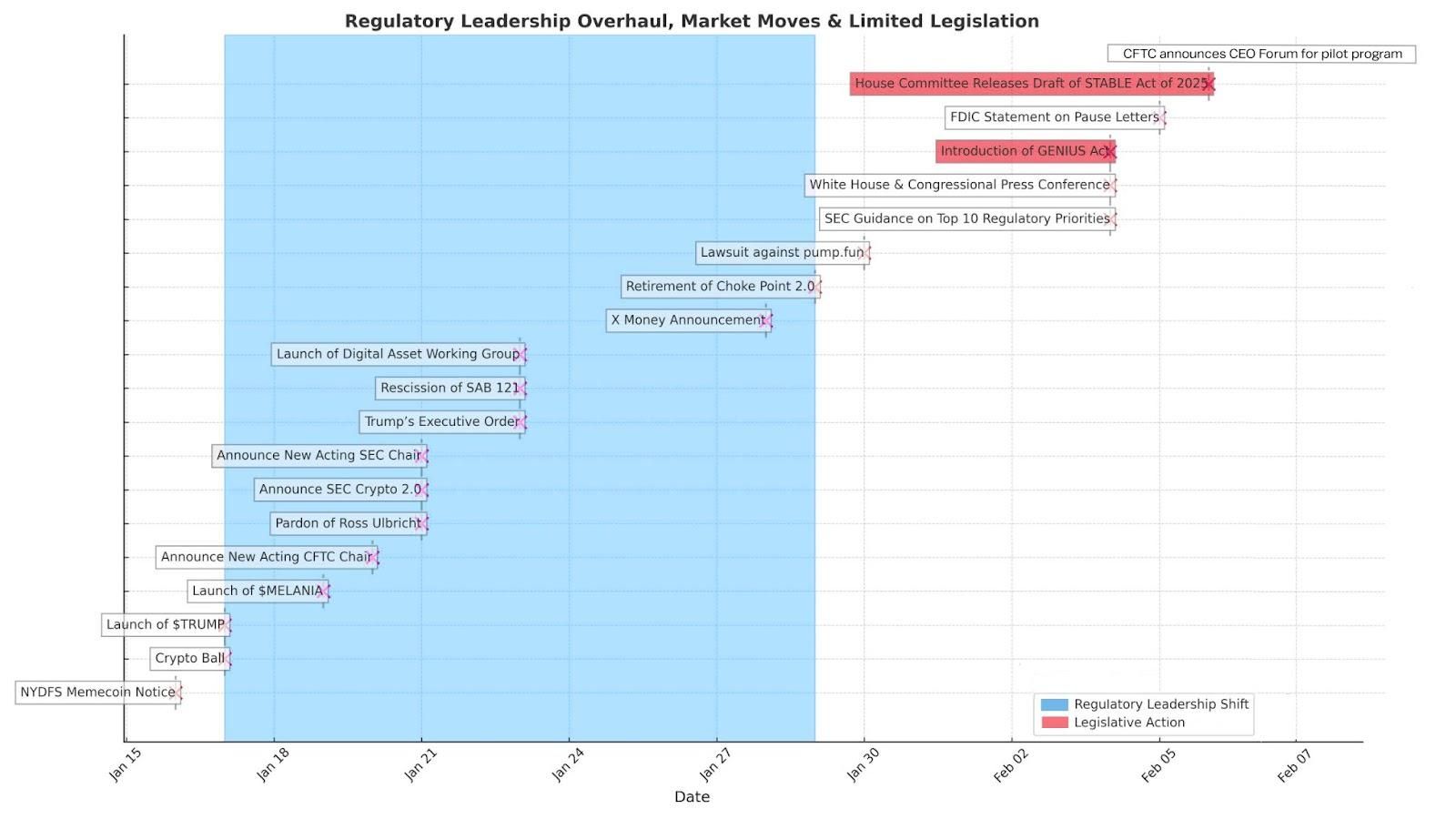
Three Key Trends to Watch
1. Acceleration of Product Innovation
The chart above clearly illustrates the Trump administration’s early focus on leadership changes and rollbacks of enforcement-driven policies. With regulatory enforcement easing, U.S. crypto development no longer needs to wait — or move offshore.
The SEC’s Crypto 2.0 initiative, led by Commissioner Peirce, shifts from enforcement-first policies to a new Crypto Taskforce. Meanwhile, the President’s Working Group on Digital Asset Markets, chaired by crypto advocate David Sacks, signals a more supportive stance. These shifts create space for innovation, allowing blockchain to prove its value before regulations catch up.
Key areas for progress include stablecoin regulation, clearer digital asset custody requirements, hybrid TradFi-crypto products (such as expected Solana and ETH ETFs) and global payments advancements through partnerships like those with X Money and Visa. Resolving complex policy priorities will take time, as reflected in a16z’s 11 priorities and the Crypto Bar’s open letter, highlighting the breadth of influential voices.
As adoption grows, the network effect of successful crypto products will push for consensus-driven regulation. But without meaningful legislative action, the industry risks a return to uncertainty when Washington’s leadership inevitably shifts again.
2. Speculation vs. Sustainable Growth
Amid all this optimism, crypto still struggles to establish credibility and prove itself as a force for responsible innovation. The opportunity to revolutionize finance is here — but is market speculation part of the growth or is it hindering sustainable growth?
Memecoins like $TRUMP and $MELANIA surged just before the inauguration, reflecting demand for high-risk, culturally driven assets, while also raising regulatory concerns about volatility and integrity. The class action lawsuit against pump.fun underscores skepticism of growth untethered to sustainable utility.
To maintain credibility, crypto must distinguish real-world and potential wealth creation applications from speculative assets. Fraud and misrepresentation remain illegal, whether in memecoins, penny stocks or collectibles. As the market evolves, businesses and investors must prioritize due diligence to separate hype from lasting potential.
3. The Urgent Need for Regulatory Clarity
Despite leadership changes, there remains an urgent need for clear, enforceable crypto regulation. Key unresolved issues include:
Addressing fraud and consumer protections without stifling innovation and decentralized finance
Defining digital asset regulatory authority among agencies
Establishing fit-for-purpose AML frameworks for stablecoins and other innovations
With crypto-friendly leaders now at the SEC and CFTC, regulatory progress is likely, but legislative action will take time. While Congress is considering proposals like the GENIUS Act, the STABLE Act, and new rules for market structure, pragmatic change isn’t guaranteed this year.
For now, the industry must keep shifting the Overton window toward recognizing crypto’s role in U.S. tech leadership, public policy and economic security. Until comprehensive laws emerge, regulatory leadership — seen with the CFTC pilot program and recent Federal Reserve speech — must guide a stable path for growth.
The Path Forward
This year is pivotal — not just because toxic policies are fading and leadership has shifted, but because momentum is driving Web3 and blockchain forward.
The goal isn’t just «responsible growth» but sustainable growth anchored in regulatory clarity. If the industry balances innovation with strong protections against fraud and theft, crypto’s resilience and credibility will be strengthened. With tech-neutral regulations, the U.S. won’t just lead in crypto and AI policy — we’ll also be ready for whatever else is next, from quantum computing to future breakthroughs. Sustainable innovation matters because technological progress is inevitable.
—Beth Haddock, managing partner and founder, Warburton Advisers
Ask an Expert
Q: Who is Ross Ulbricht?
A: Ross Ulbricht created Silk Road, an early bitcoin-powered marketplace that demonstrated crypto’s potential for decentralized commerce — both legally and illegally. His life sentence became a rallying cry in the crypto community, with many arguing it was excessive and highlighting broader debates on financial privacy and government control. His recent pardon has reignited discussions on justice reform and crypto’s role in the future of digital trade.
Q: What are the risks of memecoins?
A: Memecoins like $TRUMP and $MELANIA are highly speculative, with prices driven more by social media hype than real utility. While they can generate quick profits, they also carry extreme volatility and risks of manipulation. Many lack long-term viability, so investors should approach them with caution and avoid putting more in them than they can afford to lose.
Q: How could state bitcoin investments impact adoption?
A: If states allocate reserves to bitcoin, it could legitimize crypto as a store of value, encouraging institutional investors and policymakers to take it more seriously. This could accelerate regulatory clarity, enhance calls for clearer tax guidelines and integrate bitcoin into broader financial infrastructure, helping solidify its role in the economy.
—DJ Windle, founder and portfolio manager, Windle Wealth
Keep Reading
Abu Dhabi’s sovereign wealth fund, Mubadala, has invested approximately $437 million into BlackRock’s bitcoin ETF.
Google looks to simplify bitcoin adoption with wallet integration alongside existing authentication protocols.
FTX’s initial $1.2 billion payout is underway, with creditors with claims of less than $50,000 starting to receive payouts.
Uncategorized
Wall Street Bank Citigroup Sees Ether Falling to $4,300 by Year-End

Wall Street giant Citigroup (C) has launched new ether (ETH) forecasts, calling for $4,300 by year-end, which would be a decline from the current $4,515.
That’s the base case though. The bank’s full assessment is wide enough to drive an army regiment through, with the bull case being $6,400 and the bear case $2,200.
The bank analysts said network activity remains the key driver of ether’s value, but much of the recent growth has been on layer-2s, where value “pass-through” to Ethereum’s base layer is unclear.
Citi assumes just 30% of layer-2 activity contributes to ether’s valuation, putting current prices above its activity-based model, likely due to strong inflows and excitement around tokenization and stablecoins.
A layer 1 network is the base layer, or the underlying infrastructure of a blockchain. Layer 2 refers to a set of off-chain systems or separate blockchains built on top of layer 1s.
Exchange-traded fund (ETF) flows, though smaller than bitcoin’s (BTC), have a bigger price impact per dollar, but Citi expects them to remain limited given ether’s smaller market cap and lower visibility with new investors.
Macro factors are seen adding only modest support. With equities already near the bank’s S&P 500 6,600 target, the analysts do not expect major upside from risk assets.
Read more: Ether Bigger Beneficiary of Digital Asset Treasuries Than Bitcoin or Solana: StanChart
Uncategorized
XLM Sees Heavy Volatility as Institutional Selling Weighs on Price
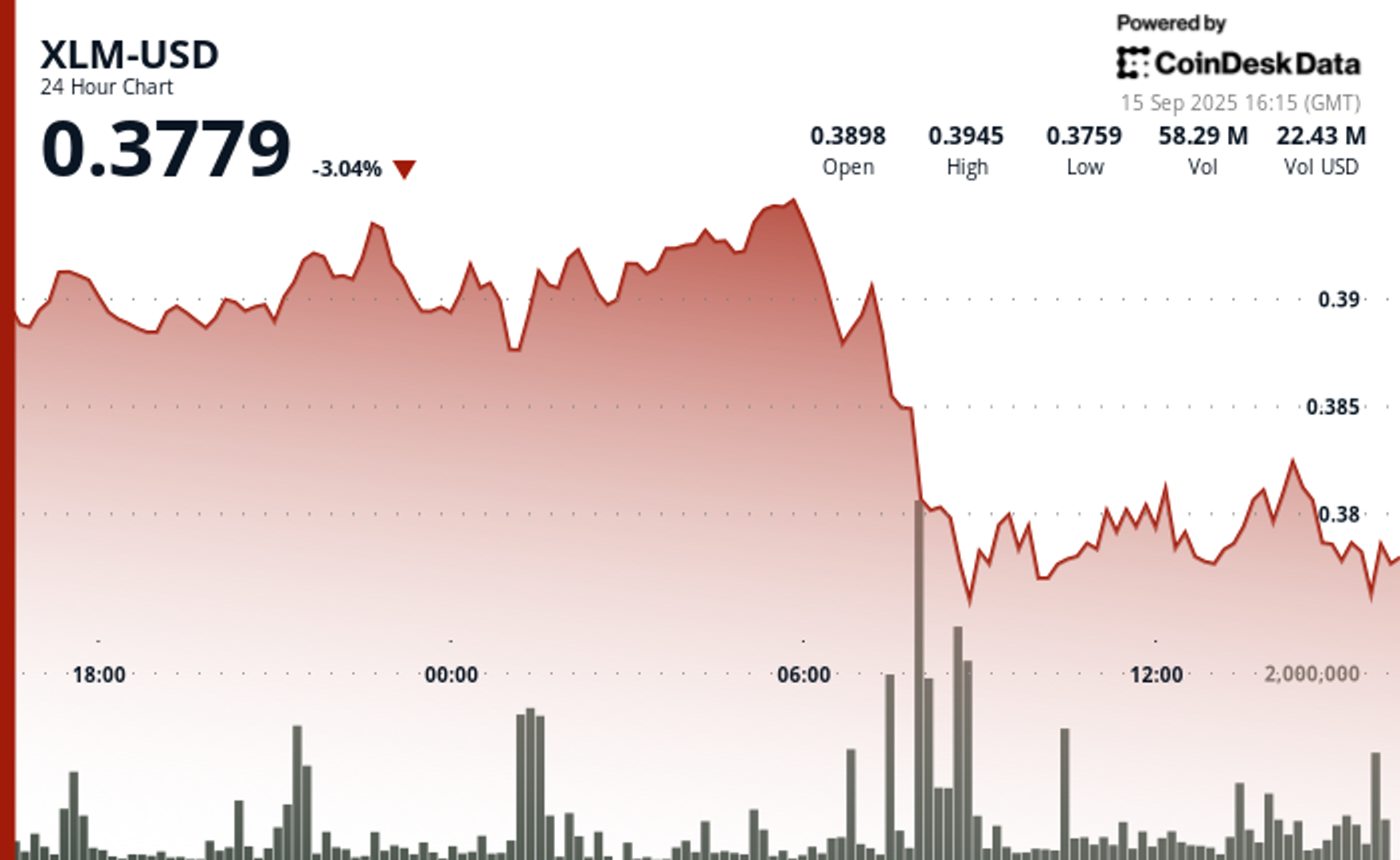
Stellar’s XLM token endured sharp swings over the past 24 hours, tumbling 3% as institutional selling pressure dominated order books. The asset declined from $0.39 to $0.38 between September 14 at 15:00 and September 15 at 14:00, with trading volumes peaking at 101.32 million—nearly triple its 24-hour average. The heaviest liquidation struck during the morning hours of September 15, when XLM collapsed from $0.395 to $0.376 within two hours, establishing $0.395 as firm resistance while tentative support formed near $0.375.
Despite the broader downtrend, intraday action highlighted moments of resilience. From 13:15 to 14:14 on September 15, XLM staged a brief recovery, jumping from $0.378 to a session high of $0.383 before closing the hour at $0.380. Trading volume surged above 10 million units during this window, with 3.45 million changing hands in a single minute as bulls attempted to push past resistance. While sellers capped momentum, the consolidation zone around $0.380–$0.381 now represents a potential support base.
Market dynamics suggest distribution patterns consistent with institutional profit-taking. The persistent supply overhead has reinforced resistance at $0.395, where repeated rally attempts have failed, while the emergence of support near $0.375 reflects opportunistic buying during liquidation waves. For traders, the $0.375–$0.395 band has become the key battleground that will define near-term direction.
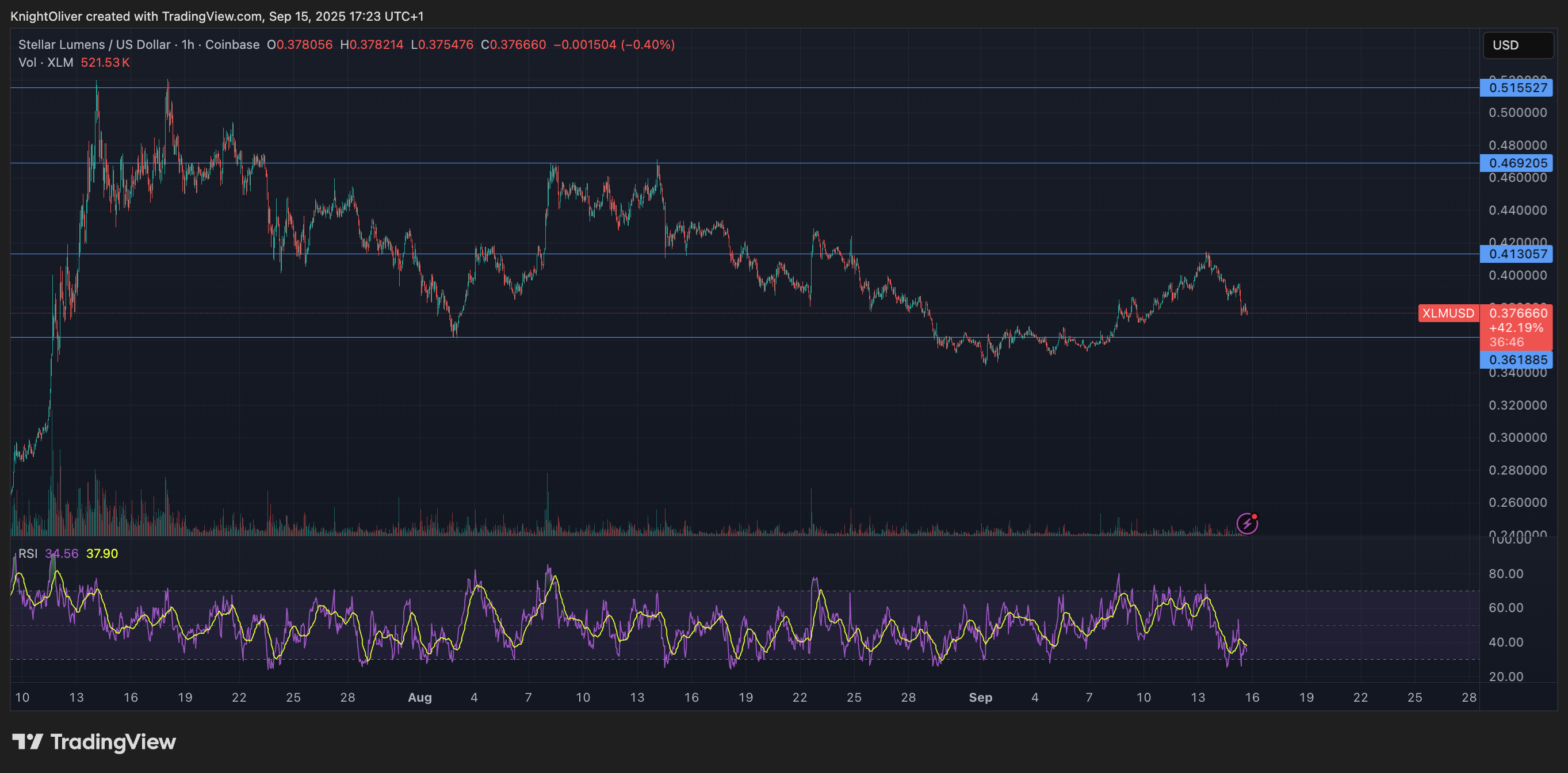
Technical Indicators
- XLM retreated 3% from $0.39 to $0.38 during the previous 24-hours from 14 September 15:00 to 15 September 14:00.
- Trading volume peaked at 101.32 million during the 08:00 hour, nearly triple the 24-hour average of 24.47 million.
- Strong resistance established around $0.395 level during morning selloff.
- Key support emerged near $0.375 where buying interest materialized.
- Price range of $0.019 representing 5% volatility between peak and trough.
- Recovery attempts reached $0.383 by 13:00 before encountering selling pressure.
- Consolidation pattern formed around $0.380-$0.381 zone suggesting new support level.
Disclaimer: Parts of this article were generated with the assistance from AI tools and reviewed by our editorial team to ensure accuracy and adherence to our standards. For more information, see CoinDesk’s full AI Policy.
Uncategorized
HBAR Tumbles 5% as Institutional Investors Trigger Mass Selloff
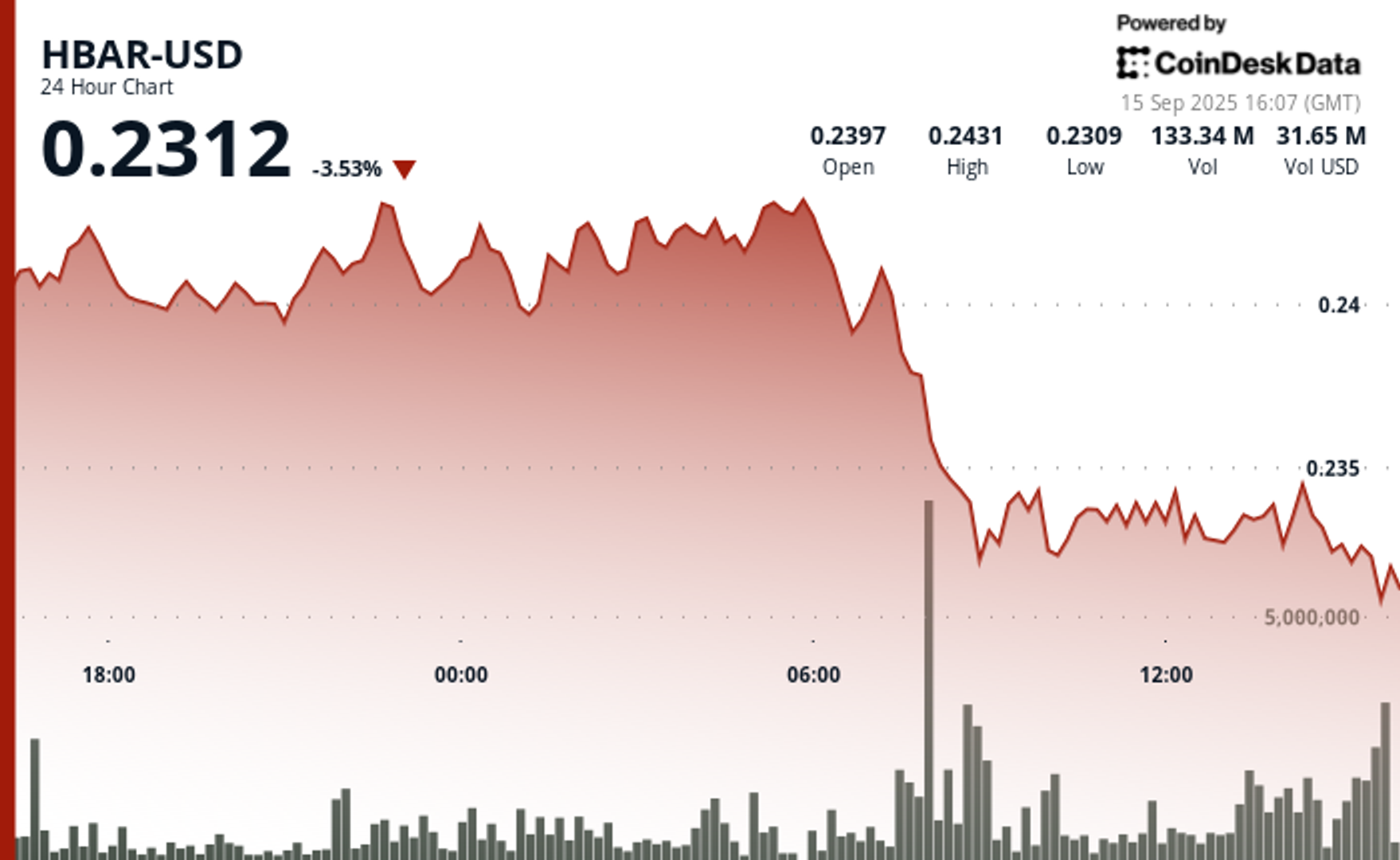
Hedera Hashgraph’s HBAR token endured steep losses over a volatile 24-hour window between September 14 and 15, falling 5% from $0.24 to $0.23. The token’s trading range expanded by $0.01 — a move often linked to outsized institutional activity — as heavy corporate selling overwhelmed support levels. The sharpest move came between 07:00 and 08:00 UTC on September 15, when concentrated liquidation drove prices lower after days of resistance around $0.24.
Institutional trading volumes surged during the session, with more than 126 million tokens changing hands on the morning of September 15 — nearly three times the norm for corporate flows. Market participants attributed the spike to portfolio rebalancing by large stakeholders, with enterprise adoption jitters and mounting regulatory scrutiny providing the backdrop for the selloff.
Recovery efforts briefly emerged during the final hour of trading, when corporate buyers tested the $0.24 level before retreating. Between 13:32 and 13:35 UTC, one accumulation push saw 2.47 million tokens deployed in an effort to establish a price floor. Still, buying momentum ultimately faltered, with HBAR settling back into support at $0.23.
The turbulence underscores the token’s vulnerability to institutional distribution events. Analysts point to the failed breakout above $0.24 as confirmation of fresh resistance, with $0.23 now serving as the critical support zone. The surge in volume suggests major corporate participants are repositioning ahead of regulatory shifts, leaving HBAR’s near-term outlook dependent on whether enterprise buyers can mount sustained defenses above key support.
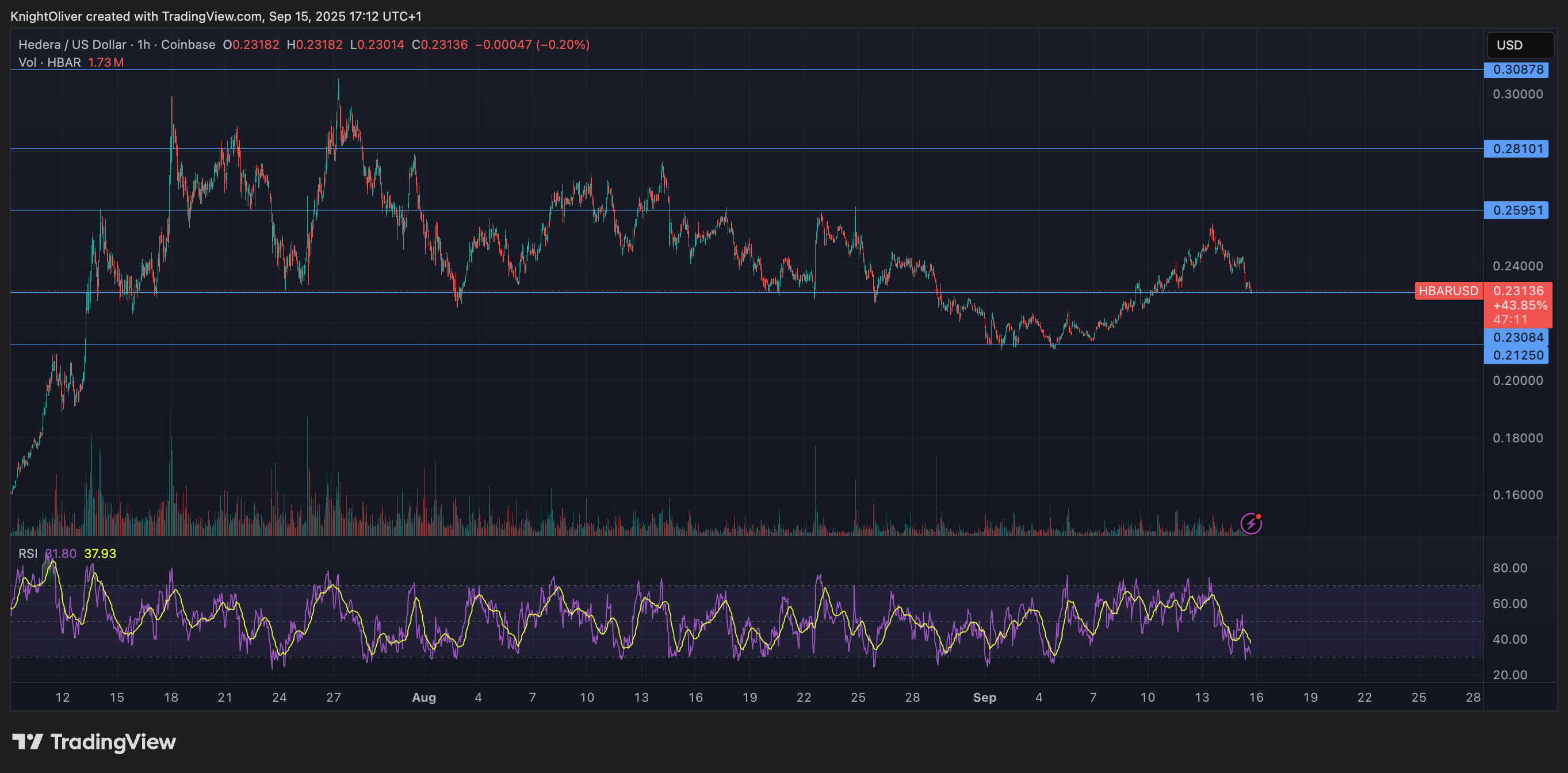
Technical Indicators Summary
- Corporate resistance levels crystallized at $0.24 where institutional selling pressure consistently overwhelmed enterprise buying interest across multiple trading sessions.
- Institutional support structures emerged around $0.23 levels where corporate buying programs have systematically absorbed selling pressure from retail and smaller institutional participants.
- The unprecedented trading volume surge to 126.38 million tokens during the 08:00 morning session reflects enterprise-scale distribution strategies that overwhelmed corporate demand across major trading platforms.
- Subsequent institutional momentum proved unsustainable as systematic selling pressure resumed between 13:37-13:44, driving corporate participants back toward $0.23 support zones with sustained volumes exceeding 1 million tokens, indicating ongoing institutional distribution.
- Final trading periods exhibited diminishing corporate activity with zero recorded volume between 13:13-14:14, suggesting institutional participants adopted defensive positioning strategies as HBAR consolidated at $0.23 amid enterprise uncertainty.
Disclaimer: Parts of this article were generated with the assistance from AI tools and reviewed by our editorial team to ensure accuracy and adherence to our standards. For more information, see CoinDesk’s full AI Policy.
-

 Business11 месяцев ago
Business11 месяцев ago3 Ways to make your business presentation more relatable
-

 Fashion11 месяцев ago
Fashion11 месяцев agoAccording to Dior Couture, this taboo fashion accessory is back
-

 Entertainment11 месяцев ago
Entertainment11 месяцев ago10 Artists who retired from music and made a comeback
-

 Entertainment11 месяцев ago
Entertainment11 месяцев ago\’Better Call Saul\’ has been renewed for a fourth season
-

 Entertainment11 месяцев ago
Entertainment11 месяцев agoNew Season 8 Walking Dead trailer flashes forward in time
-

 Business11 месяцев ago
Business11 месяцев ago15 Habits that could be hurting your business relationships
-

 Entertainment11 месяцев ago
Entertainment11 месяцев agoMeet Superman\’s grandfather in new trailer for Krypton
-

 Entertainment11 месяцев ago
Entertainment11 месяцев agoDisney\’s live-action Aladdin finally finds its stars





